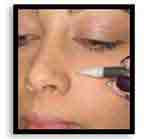Tattoo Removal
Questions and Answers
Tattoo Removal Questions and Answers | Removal Facts
- Professionally tattoos penetrate deeper in the skin at the same depth
Some newer inks, pastel, and lighters colors may be difficult to completely remove - Removal of handmade tattoos may be more difficult to remove
- Deeper blue and black are the easiest to remove
- Newer tattoos are more difficult to remove (debated, but our practices opinion)
- Removing the tattoo 100% is not always possible
- Some scarring or hypopigmentation is a possibility
- Tattoo removal is a safe outpatient procedure
- Tattoo removal can be used on darker skin.
- About 25% of the U.S. population has a tattoo of some sort
- 50% of them want them removed!
Tattoo Removal Questions and Answers page is for you and we can help you make a more educated decision but we can never promise a complete fade, nor how many sessions it will take!

Q: What do you use to remove a tattoo?
A: Advanced LTR- Body Beautiful uses advanced tattoo removal lasers such as Medlite Hoya Con Bio, Q-switch Nd YAG laser which is extremely efficient at eliminating a broad spectrum of colored ink and the most advanced and effective laser the PicoSure.
Q: How exactly does the laser break up the tattoo ink?
A: Two key processes break up the ink – the pigment in your tattoo will absorb the energy from the laser and break it apart. Furthermore, the incredibly fast pulse and energy of the laser will cause the ink to shatter- break down like a sugar cube breaking apart. Colors such as light green, light blue, and teal or turquoise are more challenging to eliminate altogether and patients should assume that no more than 70-80% of this ink may be removed unless a tattoo is quite old, 20or more years in most cases. The TriWave is more effective than any available laser at breaking down a considerable amount of this ink when used by a highly-trained laser specialist.
Q: How does the body remove the shattered ink?
A: After the tattoo ink has been broken down by the Tattoo Removal Laser, the body will react by pushing fluid to the region to help flush away the ink. The immune response will be obvious to the patient in the form of swelling and redness in the area. Over the next several weeks the ink will be flushed away. This doesn’t happen overnight. Removing a tattoo takes a number of sessions.
Q: Why do I need multiple sessions?
A: Every tattoo comprises of layers of ink stacked atop of each other. Furthermore, these tattoos have a thick concentration of color particles that cannot be completely broken down in one session. At Body Beautiful we’ll go over your entire tattoo with the laser, breaking up as much ink as possible in every session. Each session will produce some level of fading, although for very new tattoos the fading may not be as visible because the ink is still so thick and dense. Some tattoo may have shading if yours does, it will be removed with an amazing level of ability because shading is just a tattoo without a sufficient amount of ink density. It may only take a few sessions to remove this shading.
Q: Does it hurt?
A: Patients describe the feeling like a rubber band slapping off your skin. Many say its actually less painful than getting the tattoo in the first place and takes just minutes.
Q: What should I expect after getting this procedure?
A: You may experience swelling or a blister for the first few days after the treatment as well as white scabbing immediately following. Continued loss of appearance of the tattoo can be observed for 4-8 weeks after each treatment. Treat with antibiotic ointment to aid the healing process and prevent infection. If needed, you may take something along the lines of Tylenol for pain and elevate the treated area to prevent swelling. Make sure to stay out of the sun. Pigmentary changes may occur following laser treatment-so it is possible that your skin may either lighten or darken. The latter is more common following sun exposure.
Q: What is laser tattoo removal?
A: The removal of tattoos is achieved by Selective Thermolysis – (chemical dissipation by means of heat-which basically evaporates your tattoo). Lasers deliver energy targeted toward the carbon particles or dyes found in the tattoo. This allows the foreign pigment to be selectively destroyed while minimizing damage to your skin.
Q: What kind of laser is used for this procedure?
A: Q-switched laser stands for ‘quality-switched laser’ which refers to the fact that the laser’s objective is to use short pulses of light energy and focus it at the tattoo cracking open the pigments. The skin produces cells called ‘macrophages’ which are equipped to eliminate these broken down colors of the tattoo. These lasers are effective at targeting the tattoo with minimal or no damage to the surrounding skin.
Q: Who is a candidate for getting this procedure?
A: Whether they were from medical procedures, injuries, homemade or professionally done. Although each tattoo color responds differently to treatment, anyone is a good candidate for laser tattoo removal.
Q: Will I have a scar?
A: The chance of scarring is less then 5% if you follow the aftercare instructions, However, risk of scarring can increase for pregnancy, bad circulation, dark skin tone, immune system deficiencies, Accutane use, some health circumstances, using certain medicines, or possessing a history of keloids or elevated scarring. Every individual is different. Please share correct information on paperwork and anything medically new that may occur between sessions.
Q: Will all shades of ink disappear proportionately as well?
A: No, but black ink removes the best. Red, orange, pink, and warmer colors respond well. Purple and yellow are variable but usually removes well. Now (since May 2008) we are able to more successfully remove green and teal blue ink. White, flesh tones, and permanent make-up can turn darker with laser and must be tested before treatment. * As we always work hard to earn loyalty – if you had this service “before” 2009, and did not get full results; you are welcome to come in for a complimentary treatment to make a further educated decision. Some white ink may not be detected by the laser (but check back often for any updates).
Q: How many treatments will I need?
A: Because every individual and tattoo is different there is not an exact number of treatments we are able to give for tattoo removal although we know it will take multiple treatments. Factors in the number of treatments are how old tattoo is, was it done professionally, what colors were used, how many layers deep is a tattoo, etc…
Q: How much does the PicoSure treatment cost?
A: During your consultation, we will estimate the number of treatments needed and measure your tattoo to determine a cost.
Q: How many treatments does it take to remove a tattoo with the PicoSure?
A: Every person responds differently to laser tattoo removal. Due to the variations of ink, colors, skin type, immune factors, and genetics, we can only provide an educated estimate. During your consultation, the technician will provide you with an estimated cost and the number of treatments we think you will need. See our before and after to see our satisfied PicoSure customers.
Q: Tattoo Removal Questions and Answers | What medications should I avoid prior to my laser tattoo removal?
A: Review our sun-sensitive medications list.
Q: What are the typical post-treatment side effects that I will see on my tattoo?
A: Patients may notice hypopigmentation, pinpoint bleeding, edema, blistering, or erythema. This is normal; it’s the body’s way of keeping the treated area cool to allow for fast healing. If it’s bothering you, apply a sterilized cold compress to the area and/or contact us at 724 987 3221.











